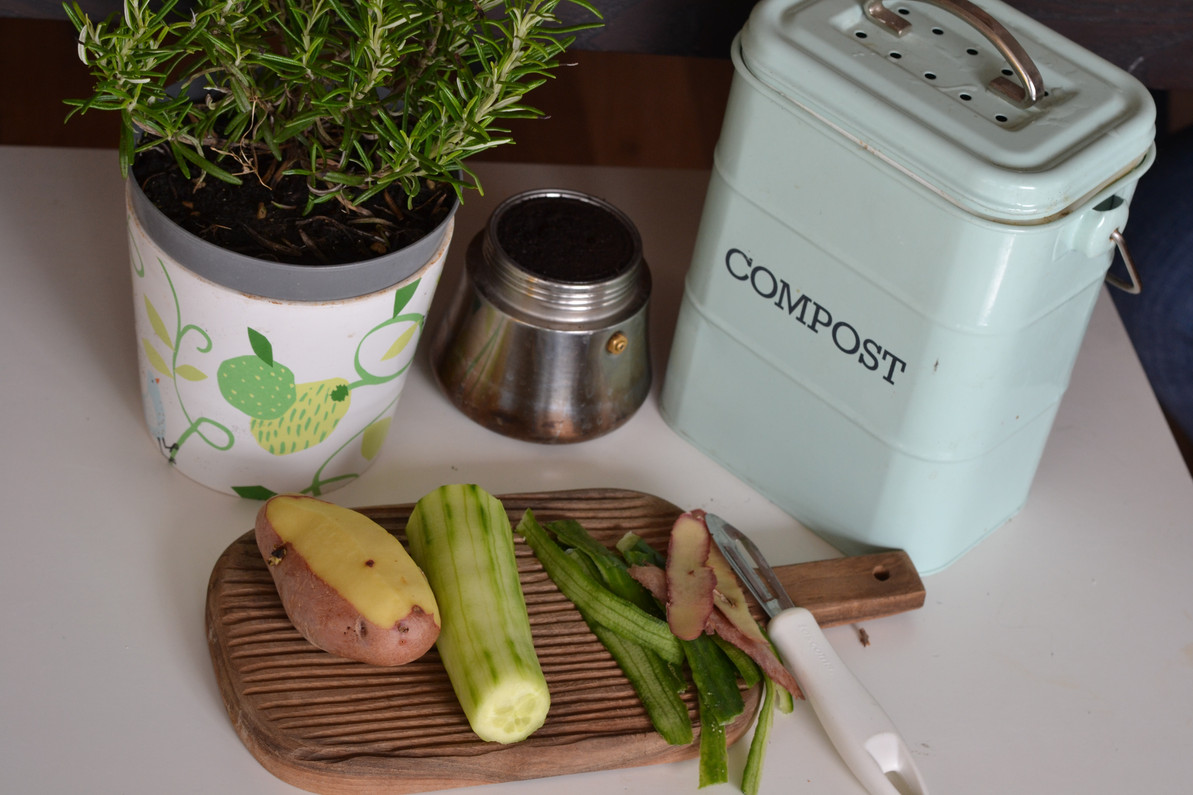Composting Season is Here! Check Out Our Composting Guide
For those of us in the Northeast at least, the cold winter months have come to a close and it's once again time to bring out the rakes and start the gardens and compost heaps.
Personally I had always grown up composting as a child, with a big ugly blue plastic tumbling bin in our backyard and a small slightly smelly pot on the kitchen counter. Though I lived in PA, me and my family and some family friends would go to two music festivals in upstate New York every year. At both of these, the same composting organization that is an extension of Cornell University put on a wonderful show titled "Compost Theater" that comically teaches children the process and importance of composting using songs, costumes, and fun audience interactions. As a kid this was the highlight of the festivals for me, and I made sure I never missed their show and saw it twice each year. I do truly believe that this little show played a part in creating the environmentally-minded person that I am today, and suggest to any reading this in the NY area to check them out! They also had wonderful volunteer-driven operations in which they would collect and educate about compost all around the events.
Now that I'm grown with a home of my own next door in New Jersey, this is my second year experimenting with a garden and my first year with a nice rotating compost barrel of my own. Though I'm not new to composting, I was still unsure of where to start with my new sparkly clean bin and thought it was best to try and jog my memory. After I jumped down the rabbit hole of composting guides, tips, and tricks, I decided to compile the best information I found across multiple sites to create a guide of my own that I can update as I continue on my composting journey. So here it goes.
Step 1: Choose Your Composting Style
- For those with lots to compost & lots of outdoor space, the best option is the traditional outdoor compost heap. You can start your pile at ground-level with a fenced off area of about 3x3x3ft, or go larger if necessary. You should start with a layer of twigs or straw before adding other scraps.
- For small to medium homes & outdoor spaces, opt for an outdoor rotating compost bin. The ability to spin them makes it easier without you having to manually turn over the compost pile, and the elevated styles help to keep away pests. Many will also come with two separate compartments so you can have two bins composting at different stages at the same time.
- For those with apartments or smaller homes or families there are some smaller indoor composting options, and compost has little to no smell when done properly! Those with greater means and a passion for sustainable innovation may try the new famous Lomi, though it is fairly expensive and is controversial in many sustainable circles as it uses electricity and may not technically be considered composting. Other small countertop composters are available to try and if you have space in an attic or other room somewhere, there are some larger bins that are intended for indoor use, though a few extra ingredients may be required to mimic outdoor processes. Many will come with carbon filters that will help limit any smells, or if you're not too concerned about possible smells, you can opt for a DIY bucket with a few drilled air holes (or even purchase and add your own carbon filter).
Step 2: Get Your Brown/Green Ratio Down
Your compost needs a fairly stable ratio of brown matter that provides carbon to green matter that provides nitrogen in order to properly break down. Oxygen and water are also essential parts of this process, but your compost should get a sufficient amount of moisture from your food scraps or yard clippings and the turning of the compost stimulates the oxygen. Just remember to cut up your scraps and shred your paper as much as possible to quicken the process!
- Ratio: About 1:1 when first starting your compost, or about 2:1 or 3:1 browns to greens when continuing it. It may seem frustrating that more browns are needed than the greens, which is probably what most of us intend our compost for, but if you use a lot of paper towels or take a quick look for fallen leaves around your yard it isn't that hard to maintain.
- Browns: Shredded paper/newspaper or small pieces of uncoated cardboard, dirty napkins, dead leaves and small twigs, fireplace ashes from natural wood, hair or fur, hay or straw, wood chips or clean unclumped sawdust
- Greens: Fruit and veggie scraps, egg shells and nutshells, used coffee grounds and filters, grains and breads (though scarcely and try to bury them if kept outside), grass clippings, fresh leaves or houseplants, tea bags or leaves, flower cuttings
What to keep out of your compost:
- Any meat or dairy products as they will attract unwanted attention from animals and pests. Large composting facilities often have the size capacity and resources to avoid this and process such waste, but home composting piles are better off without them
- Avoid any oily food products or products with oil residue, and be careful with bread products as noted above
- Banana peels, peach peels, and orange rinds as they can contain remnants of chemical pesticides
- Bioplastics as most plastics advertised as compostable can only be handles by larger industrial composting facilities and are not meant for backyard composting unless specifically stated
- Coal/charcoal ash or anything from black walnuts as either could be harmful to other plants
- Diseased or insect-ridden plants as they could transfer their issues to other plants
- Pet waste or litter as they could transfer diseases to humans
- Trimmings treated with chemical pesticides as they could kill the beneficial composting organisms
Step 3: Add an Accelerator
Especially if you are starting your compost pile or bin for the first time, it helps to add a nitrogen accelerator to help get the compost process moving. This can be a handful of coffee grounds, manure, healthy soil, or some finished compost from another pile.
Step 4: Turn Baby Turn, But Don't Let It Burn
- Outdoor compost heaps should be turned over with a garden fork or shovel about once a week during the warmer months and once a month or so during the colder months. This can be done less if you have lots of large materials like straw. Sprinkle your additions to your compost heap in thin layers and avoid large clumps or piles and make sure to mix it to speed up the composting process. Outdoor compost heaps should also be covered with some sort of roof or top to keep it from being inundated with rain and keep the heat and moisture in.
- Rotating barrels or tumblers should be spun every 2-3 days when starting out, and can be less frequent when the compost starts to mature.Just remember that heat is an important element that helps break down your compost, so while turning it is essential and beneficial, turning it too much can reduce that internal temperature.
- For smaller indoor bins you can simply give it a good mix every time you add in some new scraps.
- Keep an eye on the moisture level: It should be about as moist as a wrung-out sponge. If it seems too dry, simply add a small cup of water and mix.
Step 5: Spill The Dirt
After a few weeks of turning your compost should be naturally breaking down and turning into a wonderful pile of dirt full of healthy microorganisms that serves as a great nutrient boost for any plant. You will know your compost is ready to distribute when you can no longer recognize any of the items you put in and it has a deep earthy smell.
- Use it in your garden as regular soil or sprinkle it around your plants to give them a little nutrient boost
- Use it for landscaping as topsoil or sprinkle it around other trees and shrubs you have around your property
- Use it for your houseplants as a replacement for potting soil
- Do some guerrilla composting and sprinkle it around some plants and trees in your local city
- Donate it or give it away to others working on their gardens this summer
Step 6: Spread The Word
Composting is a smell and hassle-free activity when done properly, and it can truly do wonders for not only your garden but for our planet. An enormous amount of food is wasted and sent to landfills around the world where, without the proper environment to efficiently break it down, it simply adds to the eyesores and wafting smells we all know and have come to ignore. Many towns have started their own composting programs and there are many vigilante composting groups as well that will provide you with a bucket and a drop-off location or even pick it up at your house on a recurring basis. These larger composting facilities are great because as noted above, they can often handle dairy and meat products that are not fit for home composting, as well as other products like bioplastics, and can therefore reduce waste even further. Check to see if any such programs exist in your area, and if not, share the ease of home composting with your community and push for formal composting programs in your city.
Recent Posts
-
How To Support Sustainable Tourism
Take a moment to think of the most beautiful place you’ve ever seen while on vacation. Maybe your mi …May 14th 2024 -
How To Make Your Spring Clean More Green
When springtime rolls around, you might feel a sudden urge to rid your house of all the dust, dirt a …May 3rd 2024 -
Celebrating Mother’s Day Sustainably
On Mother’s Day, everyone scrambles to find the perfect present for the woman who gave them the gift …Apr 18th 2024




